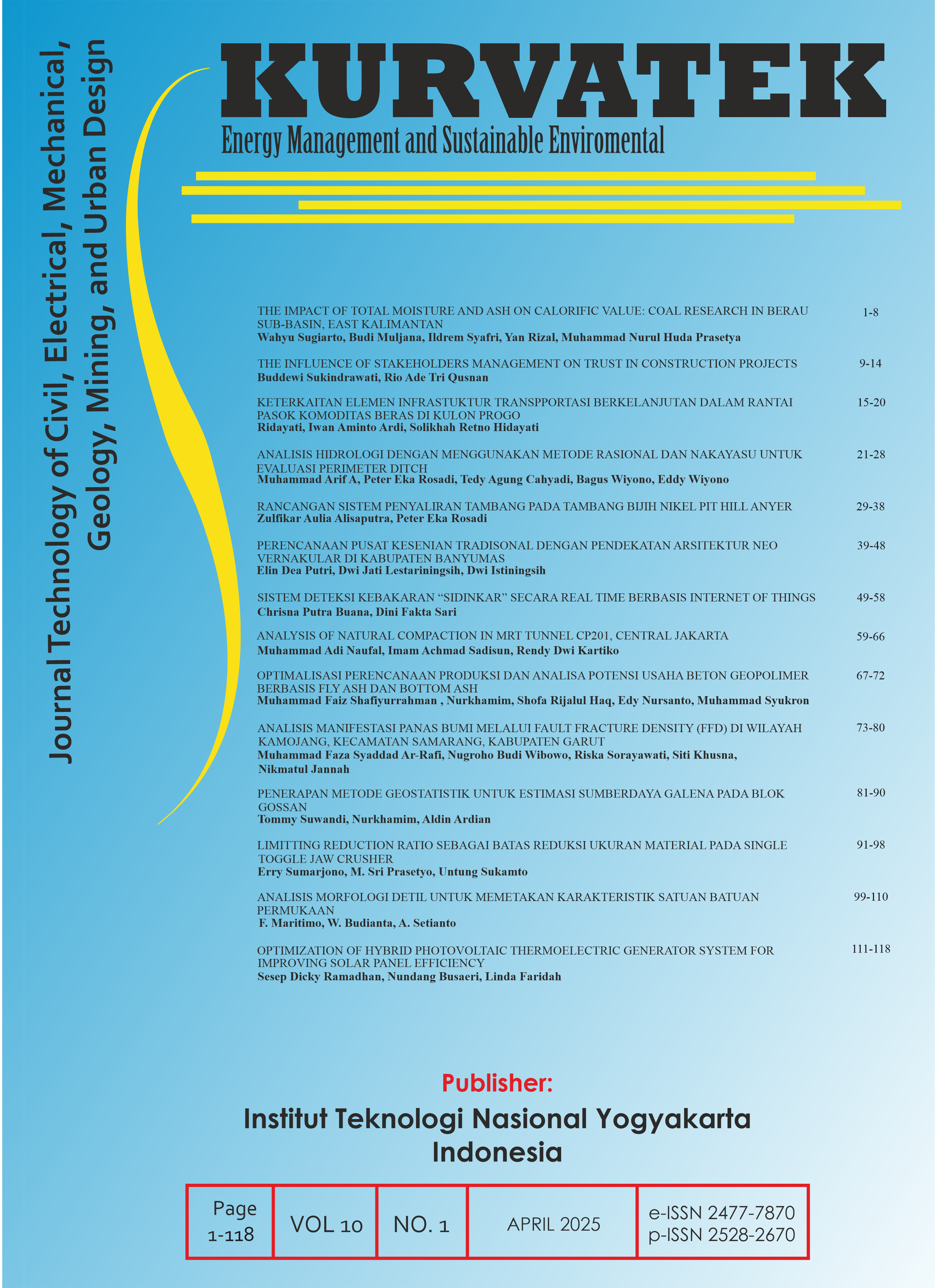OPTIMALISASI PERENCANAAN PRODUKSI DAN ANALISA POTENSI USAHA BETON GEOPOLIMER BERBASIS FLY ASH DAN BOTTOM ASH
OPTIMIZATION OF PRODUCTION PLANNING AND BUSINESS POTENTIAL ANALYSIS OF FLY ASH AND BOTTOM ASH-BASED GEOPOLYMER CONCRETE
DOI:
https://doi.org/10.33579/krvtk.v10i1.5552Keywords:
Beton, FABA, Metode simplex, Optimasi, SWOTAbstract
Dry geopolymer-based concrete from fly ash and bottom ash has been widely developed with the aim of advancing infrastructure to build a sustainable industry from the utilization of such waste. Planning for the construction of a concrete derivative product production business needs to be carried out to optimize the utilization of the budget, warehouse stock, and profit. The derivative products used in this study are paving blocks, adobes, and kanstin with compressive strength standards of 25 MPa, 10 MPa and 30 MPa respectively. Based on the compressive strength standard, the FA:BA ratio of each product is successively 3:1; 1:1; and 1:0 [1]. Therefore, the purpose of this study is to maximize profits by optimization production and raw materials based on calculations simplex linear programming method and conducting business feasibility studies using the SWOT method. Based on the calculation results, the business was focused on paving block products with a total production of 431 pcs/h. with total raw material needs of fly ash 1,199 tons / hour and bottom ash 0,399 tons / hour with a total profit of IDR 172,413. Based on the feasibility test of dry geopolymer concrete products using the SWOT method, it can be said to have great opportunities with its advantages.
Downloads
References
H. T. B. M. Petrus, F. I. Fairuz, N. Sa’adan, M. Olvianas, W. Astuti, S. N. A. Jenie, F. A. Setiawan, F. Anggara, J. J. Ekaputri, dan I. M. Bendiyasa, “Green Geopolymer Cement with Dry Activator from Geothermal Sludge and Sodium Hydroxide”, Journal of Cleaner Production, vol. 293, pp. 126143, 2021.
A. S. Adelizar, M. Olvianas, D. M. Adythia, M. F. Syafiyurrahman, I. G. Pratama, W. Astuti, dan H. T. B. M. Petrus, “Fly Ash and Bottom Ash Utilization as Geopolymer: Correlation on Compressive Strength and Degree of Polymerization Observed using FTIR”, IOP Conference Series: Materials Science and Engineering, vol. 742, no. 1, p. 1, 2020.
M. Amin dan Delvina, “Analisis Pengendalian Persediaan Bahan Baku Dengan Safety Stock Optimum”, Forum Ekonomi, vol. 23, no. 3, pp. 553–560, 2021.
M. T. Santoso dan T. Sukmono, “Analysis of Optimization of Raw Material Inventory Control Using the Linear Programming Method”, UMSIDA Preprints Server, 2023. doi: https://doi.org/10.21070/ups.3360.
S. Apriliyanti, “Optimasi Keuntungan Produksi pada Industri Kayu PT. Indopal Harapan Murni Menggunakan Linear Programming”, PASTI, vol. 13, no. 1, pp. 1–8, 2019.
Iriani, Efektivitas Perencanaan Produksi dengan Pendekatan De NOVO Programming, Surabaya: UPN “Veteran” Jawa Timur, 2012. ISBN 978-602-9372-30-4.
N. Kurniwati, “Pengendalian Persediaan Bahan Baku dalam Mengefisiensikan Biaya Persediaan dengan Metode Linear Programming”, Rekayasa Teknik Sipil, vol. 7, no. 2, 2019.
Aminudin, Prinsip-prinsip Riset Operasi, Jakarta: Erlangga, 2015.
J. Heizer dan R. Barry, Manajemen Operasi: Manajemen Keberlangsungan dan Rantai Pasokan, edisi 11, Jakarta: Salemba Empat, 2015.
Adelita, M. Hubeis, dan D. Kadarisman, “Kelayakan dan Strategi Pengembangan Usaha Pembudidayaan Tanaman Hias di Kompleks Perumahan Bekasi (Kasus Usaha Tanaman Hias Adenium pada Lahan Terbatas)”, Manajemen IKM, vol. 5, no. 2, pp. 32–41, 2010.
Downloads
Published
How to Cite
Issue
Section
License
Copyright (c) 2025 Muhammad Faiz Shafiyurrahman

This work is licensed under a Creative Commons Attribution-ShareAlike 4.0 International License.
This journal provides immediate open access to its content on the principle that making research freely available to the public supports a greater global exchange of knowledge.
All articles published Open Access will be immediately and permanently free for everyone to read and download. We are continuously working with our author communities to select the best choice of license options, currently being defined for this journal as follows:
• Creative Commons Attribution-ShareAlike (CC BY-SA)

This work is licensed under a Creative Commons Attribution-ShareAlike 4.0 International License.










